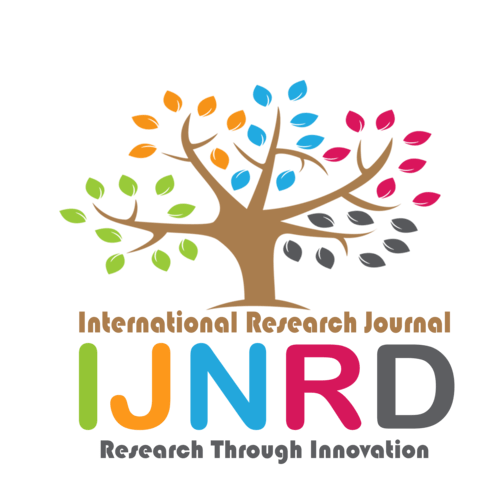|
|||||||||||||||

|
INTERNATIONAL JOURNAL OF NOVEL RESEARCH AND DEVELOPMENT International Peer Reviewed & Refereed Journals, Open Access Journal ISSN Approved Journal No: 2456-4184 | Impact factor: 8.76 | ESTD Year: 2016 Scholarly open access journals, Peer-reviewed, and Refereed Journals, Impact factor 8.76 (Calculate by google scholar and Semantic Scholar | AI-Powered Research Tool) , Multidisciplinary, Monthly, Indexing in all major database & Metadata, Citation Generator, Digital Object Identifier(DOI) |
||||||||||||||
Issue: April 2024
Volume 9 | Issue 4
Review Result and Publication of Paper within : 2-3 days
Click Here For more DetailsFor Authors
Forms / Download
Published Issue Details
Editorial Board
Other IMP Links
Facts & Figure
Impact Factor : 8.76
Issue per Year : 12
Volume Published : 9
Issue Published : 95
Article Submitted :
Article Published :
Total Authors :
Total Reviewer :
Total Countries :
Indexing Partner
Join RMS/Earn 300
Licence
This work is licensed under a Creative Commons Attribution-NonCommercial 4.0 International License







|
Published Paper Details
|
|
| Paper Title: | WEED DIVERSITY IN TURMERIC CROP IN ARAKU & PADERU DIVISIONS OF ESTERN GHOTS- A STUDY |
| Authors Name: | G.R.N.S.SUJATHA |
| Download E-Certificate: | Download |
| Author Reg. ID: |
IJNRD_198912
|
| Published Paper Id: | IJNRD2306175 |
| Published In: | Volume 8 Issue 6, June-2023 |
| DOI: | |
| Abstract: | The present study was carried out in a continuing experiment at the Araku valley mandal ofAlluri sita rama raju dt. for their effects on weed menace under mid hill conditions of Estern ghots. There were 24 weed species, which invaded different cropping systems. During Kharif, Ageratum sp. (28%) Cynodon dactylon (20%) and Commelina benghalensis (19%) were the predominant weeds. In Rabi, Phalaris minor (63%) was the most dominating weed followed by Coronopus didymus (10%) and Spergula arvensis (6%). In traditional ‘rice-wheat’ system 14 species in Rabi and 8 in Kharif season were found associated and species richness varied with diversification of systems. In Rabi, the highest diversity of weed species was in rice-wheat system and in Kharif weed flora was more diverse in okra, turmeric and colocasia based systems and was lower in rice-based systems. During Kharif, Cynodon dactylon had the highest important value index (IVI) irrespective of the cropping system followed by C. benghalensis. Monochoria vaginalis was the important weed in rice-based cropping systems while Ageratum sp. was important in upland systems. Ageratum sp., Polygonum sp. and C. dactylon invaded the experimental field both during Kharif and Rabi. During Kharif, the total weed count was maximum in September in okra, turmeric and colocasia, Weed count in turmeric cropping systems it was higher than 200/m2 at all the observations.It varied from 200 to 650/m2 . Ageratum sp. was the most dominant weed in Kharif, contributing 28% to total weed flora. Cynodon dactylon and Commelina benghalensis were next in dominance constituting 20% and 19% of total weed flora, respectively. Brassica sp., Monochoria vaginalis, Cyperus sp. and other weeds constituted 11, 10, 6 and 6% of total Kharif weed flora. Brassica sp., Fimbristylis sp., Artimisia argyi and Trifolium repens were observed for some time in the season. Polygonum alatum, Scirpus juncoides, Eleocharis sp., C.benghalensis and Phyllanthus niruri had sporadic appearance. In Rabi, P.minor was the most dominating weed contributing 63% to total weed flora. C. didymus (10%), S.rvensis (6%), Ageratum sp. (4%), T. repens (3%), C.dactylon (3%), Polygonum sp. (4%) and other weeds (7%) were also observed. Lathyrus aphaca, Ageratum sp., C. dactylon, Polygonum hydropiper, C. didymus, P. minor, S. rvensis, V. sativa, P. alatum, T. repens were prevalent throughout the Rabi season. Bidens pilosa and A. ludoviciana have shown their occurrence at termination of the season. Artimisia argyi, Anagallis arvensis and Stellaria media were noticed on some of the observations. |
| Keywords: | Croping systems , Weed density, Weed diversity, Weed management, Crop diversity |
| Cite Article: | "WEED DIVERSITY IN TURMERIC CROP IN ARAKU & PADERU DIVISIONS OF ESTERN GHOTS- A STUDY ", International Journal of Novel Research and Development (www.ijnrd.org), ISSN:2456-4184, Vol.8, Issue 6, page no.b654-b659, June-2023, Available :http://www.ijnrd.org/papers/IJNRD2306175.pdf |
| Downloads: | 000118761 |
| ISSN: |
2456-4184 | IMPACT FACTOR: 8.76 Calculated By Google Scholar| ESTD YEAR: 2016 An International Scholarly Open Access Journal, Peer-Reviewed, Refereed Journal Impact Factor 8.76 Calculate by Google Scholar and Semantic Scholar | AI-Powered Research Tool, Multidisciplinary, Monthly, Multilanguage Journal Indexing in All Major Database & Metadata, Citation Generator |
| Publication Details: |
Published Paper ID:IJNRD2306175 Registration ID: 198912 Published In: Volume 8 Issue 6, June-2023 DOI (Digital Object Identifier): Page No: b654-b659 Country: visakhapatnam, Andhra pradesh, India Research Area: Life Sciences Publisher : IJ Publication Published Paper URL : https://www.ijnrd.org/viewpaperforall?paper=IJNRD2306175 Published Paper PDF: https://www.ijnrd.org/papers/IJNRD2306175 |
| Share Article: | |
|
Click Here to Download This Article |
|
| Article Preview | |
|
|
|
Major Indexing from www.ijnrd.org
| Semantic Scholar | Microsaoft Academic | ORCID | Zenodo |
| Google Scholar | ResearcherID Thomson Reuters | Mendeley : reference manager | Academia.edu |
| arXiv.org : cornell university library | Research Gate | CiteSeerX | PUBLON |
| DRJI | SSRN | Scribd | DocStoc |
ISSN Details
 |
 |
ISSN: 2456-4184
Impact Factor: 8.76 and ISSN APPROVED
Journal Starting Year (ESTD) : 2016
DOI (A digital object identifier)
Conference
Open Access License Policy
Important Details
Social Media
| Copyright © 2024 - All Rights Reserved - IJNRD |












Facebook Twitter Instagram LinkedIn